人教版英语九年级Unit 2主题阅读
- 格式:docx
- 大小:23.92 KB
- 文档页数:6
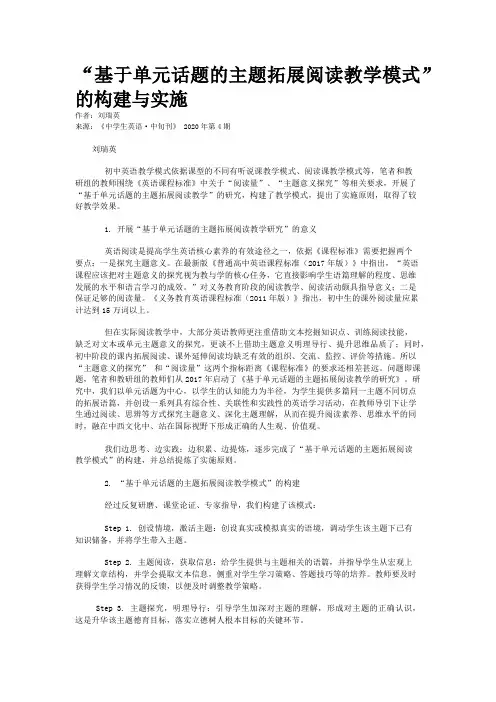
“基于单元话题的主题拓展阅读教学模式”的构建与实施作者:刘瑞英来源:《中学生英语·中旬刊》 2020年第4期刘瑞英初中英语教学模式依据课型的不同有听说课教学模式、阅读课教学模式等,笔者和教研组的教师围绕《英语课程标准》中关于“阅读量”、“主题意义探究”等相关要求,开展了“基于单元话题的主题拓展阅读教学”的研究,构建了教学模式,提出了实施原则,取得了较好教学效果。
1. 开展“基于单元话题的主题拓展阅读教学研究”的意义英语阅读是提高学生英语核心素养的有效途径之一,依据《课程标准》需要把握两个要点:一是探究主题意义。
在最新版《普通高中英语课程标准(2017年版)》中指出,“英语课程应该把对主题意义的探究视为教与学的核心任务,它直接影响学生语篇理解的程度、思维发展的水平和语言学习的成效。
”对义务教育阶段的阅读教学、阅读活动颇具指导意义;二是保证足够的阅读量。
《义务教育英语课程标准(2011年版)》指出,初中生的课外阅读量应累计达到15万词以上。
但在实际阅读教学中,大部分英语教师更注重借助文本挖掘知识点、训练阅读技能,缺乏对文本或单元主题意义的探究,更谈不上借助主题意义明理导行、提升思维品质了;同时,初中阶段的课内拓展阅读、课外延伸阅读均缺乏有效的组织、交流、监控、评价等措施。
所以“主题意义的探究” 和“阅读量”这两个指标距离《课程标准》的要求还相差甚远。
问题即课题,笔者和教研组的教师们从2017年启动了《基于单元话题的主题拓展阅读教学的研究》。
研究中,我们以单元话题为中心,以学生的认知能力为半径,为学生提供多篇同一主题不同切点的拓展语篇,并创设一系列具有综合性、关联性和实践性的英语学习活动,在教师导引下让学生通过阅读、思辨等方式探究主题意义、深化主题理解,从而在提升阅读素养、思维水平的同时,融在中西文化中、站在国际视野下形成正确的人生观、价值观。
我们边思考、边实践;边积累、边提炼,逐步完成了“基于单元话题的主题拓展阅读教学模式”的构建,并总结提炼了实施原则。
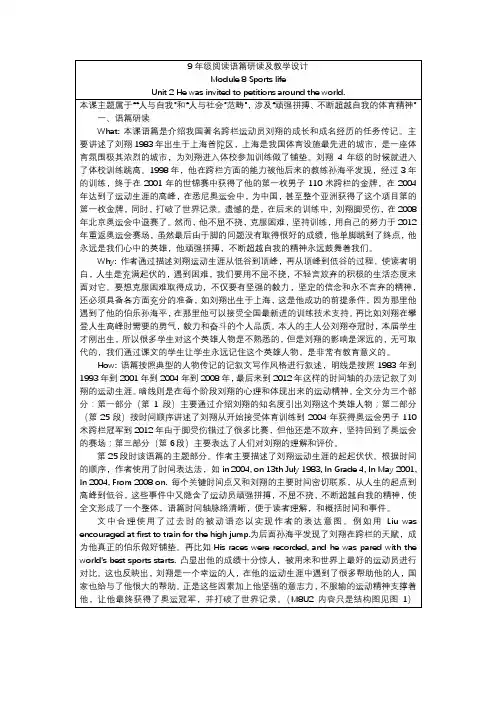
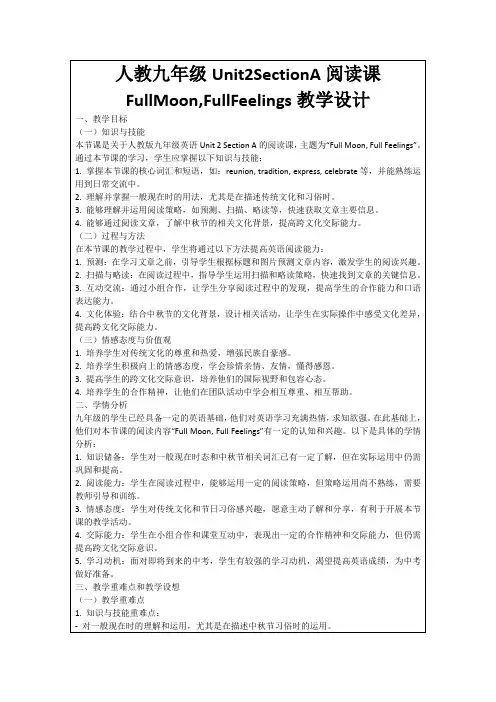
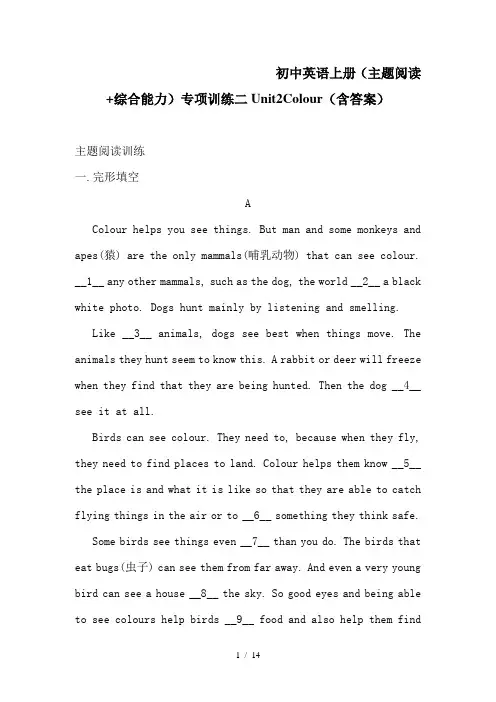
初中英语上册(主题阅读+综合能力)专项训练二Unit2Colour(含答案)主题阅读训练一.完形填空AColour helps you see things. But man and some monkeys and apes(猿) are the only mammals(哺乳动物) that can see colour. __1__ any other mammals, such as the dog, the world __2__ a black white photo. Dogs hunt mainly by listening and smelling.Like __3__ animals, dogs see best when things move. The animals they hunt seem to know this. A rabbit or deer will freeze when they find that they are being hunted. Then the dog __4__ see it at all.Birds can see colour. They need to, because when they fly, they need to find places to land. Colour helps them know __5__ the place is and what it is like so that they are able to catch flying things in the air or to __6__ something they think safe.Some birds see things even __7__ than you do. The birds that eat bugs(虫子) can see them from far away. And even a very young bird can see a house __8__ the sky. So good eyes and being able to see colours help birds __9__ food and also help them find__10__their enemies are.( )1. A. For B. With C. As D. To ( )2. A. seem like B. looks like C. likes D. like( )3. A. other B. the other C. another D. others( )4. A. may not B. should not C. must not D. need not( )5. A. how soon B. how long C. how fast D. how far( )6. A. land B. land on C. land for D. be landed( )7. A. worse B. nearer C. better D. less( )8. A. for B. inC. on D. at( )9. A. to look at B. look at C. find D. found( )10. A. whereB. when C. if D. thatBWe live in a colourful world. In different countries, colours have __1__ meanings. They are used to __2__ different holidays. In ancient Rome, a red flag was a __3__ for battle(战。
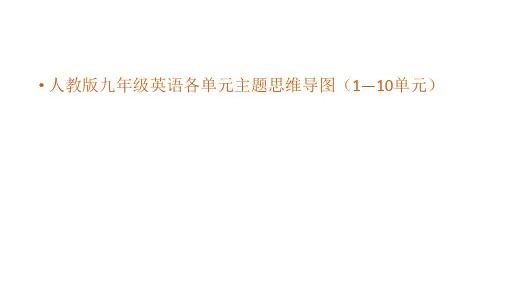
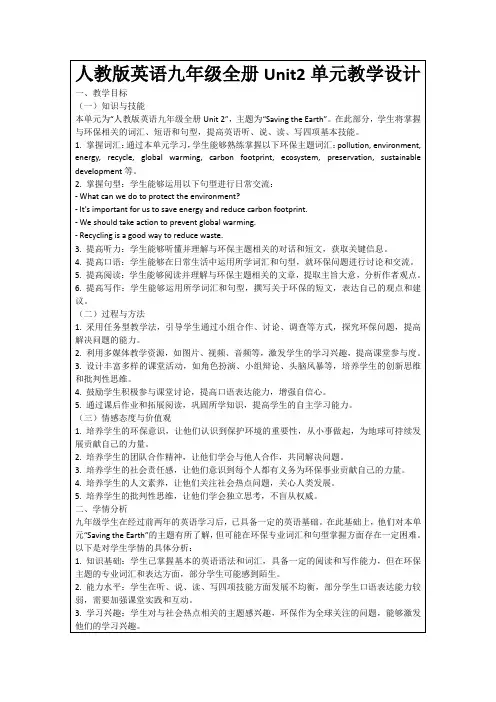
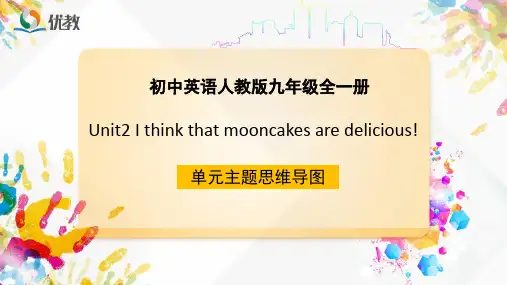
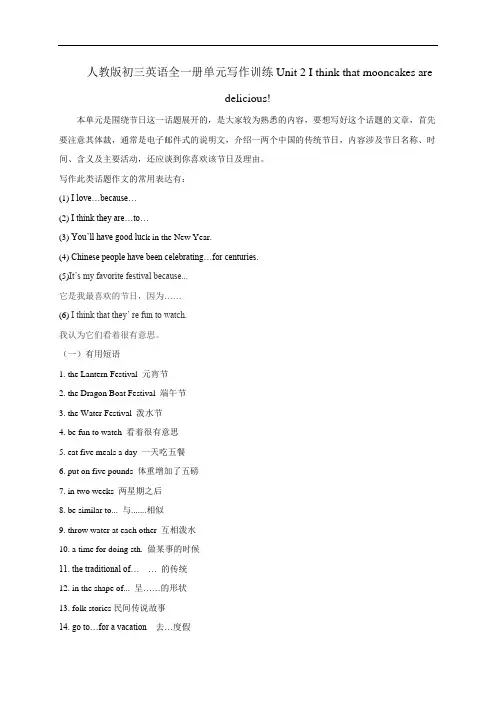
人教版初三英语全一册单元写作训练Unit 2 I think that mooncakes aredelicious!本单元是围绕节日这一话题展开的,是大家较为熟悉的内容,要想写好这个话题的文章,首先要注意其体裁,通常是电子邮件式的说明文,介绍一两个中国的传统节日,内容涉及节日名称、时间、含义及主要活动,还应谈到你喜欢该节日及理由。
写作此类话题作文的常用表达有:(1) I love…because…(2) I think they are…to…(3) You’ll have good luc k in the New Year.(4) Chinese people have been celebrating…for centuries.(5)It’s my favorite festival because...它是我最喜欢的节日,因为……(6)I think that they’ re fun to watch.我认为它们看着很有意思。
(一)有用短语1. the Lantern Festival 元宵节2. the Dragon Boat Festival 端午节3. the Water Festival 泼水节4. be fun to watch 看着很有意思5. eat five meals a day 一天吃五餐6. put on five pounds 体重增加了五磅7. in two weeks 两星期之后8. be similar to... 与.......相似9. throw water at each other 互相泼水10. a time for doing sth. 做某事的时候11. the traditional of… … 的传统12. in the shape of... 呈……的形状13. folk stories民间传说故事14. go to…for a vacation 去…度假15. wash away 冲走;洗掉16. lay out摆开;布置17. end up最终成为;最后处于18. share sth. with sb. 与……分享……19. as a result结果20. one,. . the other... (两者中的)一个……另一个……21. take sb. out for dinner 带某人出去吃饭22. dress up 乔装打扮23. haunted house 鬼屋24. trick or treat (万圣节用语)不给糖果就捣蛋25. fly up to… 飞向…26. take sb. around…带某人到处走走27. play a trick on sb.捉弄某人28. give out 分发29. the importance of…. …..的重要性30. care about….. 关心31. call out 大声呼喊32. remind sb. of 使某人想起33. sound like 听起来像34. treat sb. with. 用/以……对待某人35. the beginning of new life 新生命的开始36. the spirit of.. . ….的精神37.on October the 31st 在10月31日38.how touching 多么动人39.have good luck in the new year在新的一年里有好运气40. in need 需要帮助;处于困境中41. not only…but also…不但…而且…42. between…and… 在…和…之间【典型例题】假如你是李磊,你的美国笔友Tom对中国传统文化很感兴趣。
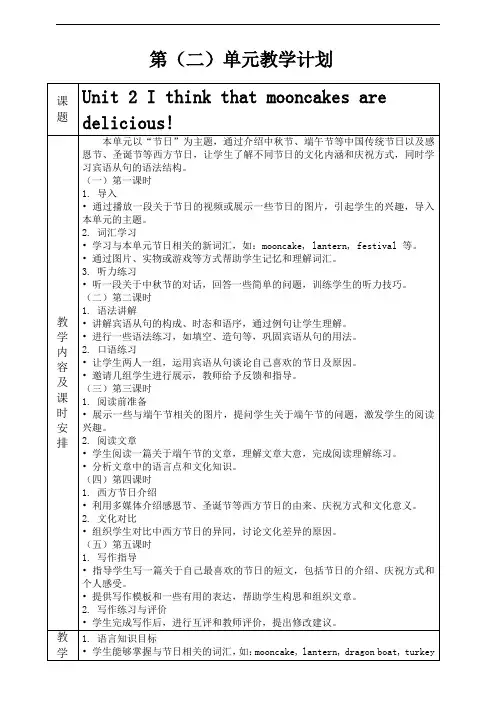
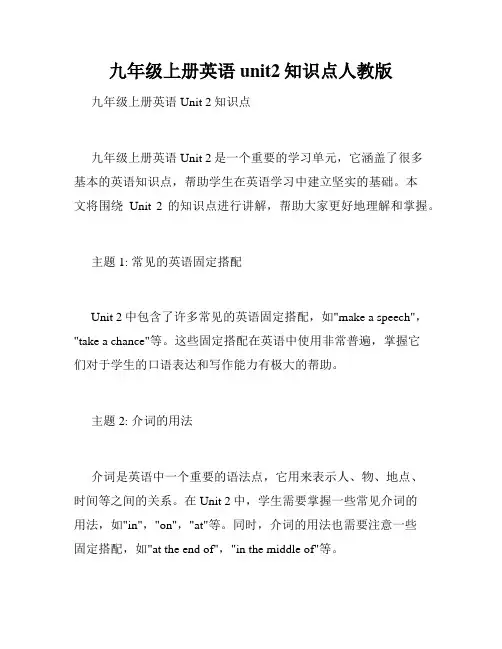
九年级上册英语unit2知识点人教版九年级上册英语Unit 2知识点九年级上册英语Unit 2是一个重要的学习单元,它涵盖了很多基本的英语知识点,帮助学生在英语学习中建立坚实的基础。
本文将围绕Unit 2的知识点进行讲解,帮助大家更好地理解和掌握。
主题1: 常见的英语固定搭配Unit 2中包含了许多常见的英语固定搭配,如"make a speech","take a chance"等。
这些固定搭配在英语中使用非常普遍,掌握它们对于学生的口语表达和写作能力有极大的帮助。
主题2: 介词的用法介词是英语中一个重要的语法点,它用来表示人、物、地点、时间等之间的关系。
在Unit 2中,学生需要掌握一些常见介词的用法,如"in","on","at"等。
同时,介词的用法也需要注意一些固定搭配,如"at the end of","in the middle of"等。
主题3: 定语从句的构成和用法定语从句在英语中起到修饰名词的作用,使句子更加精确和具体。
在Unit 2中,学生需要学会如何构成定语从句,并且掌握一些常见的关系代词和关系副词的用法,如"which","where","when"等。
主题4: 情态动词的用法情态动词是英语中非常常见的一种动词形式,它用来表示说话人对行为、态度和能力的判断和推测。
在Unit 2中,学生需要学会如何正确使用情态动词,如"can","could","should"等。
同时,情态动词的否定形式和疑问形式也需要掌握。
主题5: 名词的单复数形式名词的单复数形式是英语中一个基本的语法点,但是在实际应用中常常会出现错误。
在Unit 2中,学生需要学会名词的单复数形式以及一些不规则名词的变化规律。
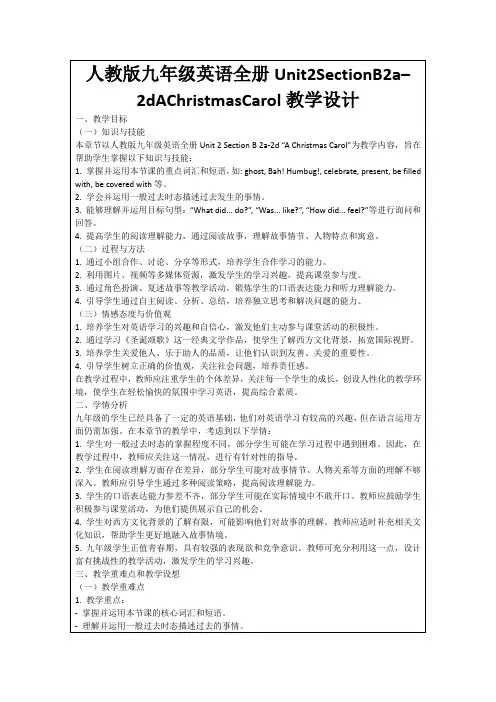
九年级英语整本书阅读教学设计The Year of Sharing教学材料名称(系列名+级别+单册英文书名):《书虫·牛津英汉双语读物》2级The Year of Sharing.课型及主题:课型:整本书阅读。
主题:人与自然、人与自我。
设计思路:本节整本书阅读课围绕“成长”这一主题,以虚构文学作品《分享年》为阅读语篇,综合运用多模态教学法、拼接图文阅读法、STEAL人物分析法等教学策略,梳理主人公与狼博弈和在鹿家庭中获取爱、分享爱的关键情节,探究主人公在分享年的独特经历中学会尊重自然、感知家庭之爱,进而收获成长的主题意义。
本节课与译林初中英语九(上)Unit4 Growing up 主题一致,从体裁和话题两方面对教材进行了有效补充,拓宽学生对“成长”这一主题理解的维度和深度。
文本分析:【What】《分享年》这部虚构文学作品与译林初中英语九上Unit4 Growing up 主题一致,属于“人与自然”及“人与自我”主题范畴,涉及“热爱与敬畏自然人与自然和谐共生”及“自我认识,自我管理,自我提升”等子主题内容,讲述了一个名叫理查德的小男孩在分享年里的经历。
理查德生活在五百年后的世界彼时没有城市,人类居住在村庄里,而森林只属于野生动物,那里一直是他们的家园。
所有的人都必须在12岁的时候履行“分享年”,即和森林里的野生动物组成新的家,一起生活一年。
小男孩理查德在这一年中,被安排和鹿群一家生活,在经受了寒冷、饥饿和疲惫,以及与狼群博弈等挑战的同时,与鹿家庭的情感连接不断加深,最终因为救鹿家人,爬到山顶引开狼群,生死未卜。
【Why】作者借“分享年”这一虚构背景设定,引发读者对自我认识和成长意义进行批判思考:通过描述理查德适应自然和与狼群博弈的过程,诠释人类应遵循自然法则、尊重自然,和大自然和谐共生的理念:同时,通过详尽刻画理查德由初入鹿家庭的不适,到建立家庭归属感的心态变化,启发读者品味家庭之爱对于人的成长的滋养。
Unit 2 Colour特色专项训练主题阅读训练AColour helps you see things. But man and some monkeys and apes(猿) are the only mammals(哺乳动物) that can see colour. __1__ any other mammals, such as the dog, the world __2__ a black white photo. Dogs hunt mainly by listening and smelling.Like __3__ animals, dogs see best when things move. The animals they hunt seem to know this. A rabbit or deer will freeze when they find that they are being hunted. Then the dog __4__ see it at all.Birds can see colour. They need to, because when they fly, they need to find places to land. Colour helps them know __5__ the place is and what it is like so that they are able to catch flying things in the air or to __6__ something they think safe.Some birds see things even __7__ than you do. The birds that eat bugs(虫子) can see them from far away. And even a very young bird can see a house __8__ the sky. So good eyes and being able to see colours help birds __9__ food and also help them find __10__their enemies are.( )1. A. For B. With C. As D. To( )2. A. seem like B. looks like C. likes D. like( )3. A. other B. the other C. another D. others( )4. A. may not B. should not C. must not D. need not( )5. A. how soon B. how long C. how fast D. how far( )6. A. land B. land on C. land for D. be landed( )7. A. worse B. nearer C. better D. less( )8. A. for B. inC. on D. at( )9. A. to look at B. look at C. find D. found( )10. A. whereB. when C. if D. thatBWe live in a colourful world. In different countries, colours have __1__ meanings. They are used to __2__ different holidays. In ancient Rome, a red flag was a __3__ for battle(战斗). In India, red is the colour of soldiers. In South Africa, red is the colour of mourning(服丧). In China, red is the colour of __4__ and it is often used at __5__. In ancient Greece, green represented victory. In England, people __6__ green as a mark of honour. Green is the national colour of Ireland. In India, yellow is for a businessman or a farmer. In China and Japan, people wear white when very sad things happened. When their relatives __7__, they usually wear white. The ancient Greeks wore white to bed to have pleasant __8__. In ancient Rome, public servants wore blue. Today the police still wear __9__.Colours can also represent different __10__. For example, you will be a leader or an active person who enjoys life if you like yellow, orange or red.( )1. A. same B. different C. some D. no( )2. A. represent B. make C. feel D. speak( )3. A. strength B. decision C. light D. sign( )4. A. good luck B. bad luck C. sadness D. politeness( )5. A. birthday parties B. weddings C. assembly D. meetings( )6. A. put on B. took off C. wore D. dressed( )7. A. are dead B. are born C. visit D. are unwele( )8. A. sleep B. asleep C. dreams D. think( )9. A. red B. white C. green D. blue( )10. A. things B. people C. feelings D. stress二.阅读理解Blue ice cream topped(浇) with black fruit sounds unmon and not delicious at all. That's the power of colour. It could either make your dinner more delicious or spoil the whole table. Scientists have found that blue may make people loseappetite(食欲). If you don't want to eat too much at your classmate's birthday party, put your cake on a blue plate. You'll stop eating soon.Why is it that people don't want to eat when they see blue? It's all in the mind. People connect the colour of food they see to the food in their memory. But where does one find blue food? There are almost no blue vegetables and no blue meat. So people have an "unmon" or " strange" feeling about the blue food.Also, people try to keep away from being poisoned. For thousands of years, people think that blue, purple and black were "colour warning signs". Foods of these colours are most probably poisonous.Then what are tasty colours? Scientists say people would like to eat more at the sight of red or colours close to it. So what should go into dishes? You need to think it over before helping your mum with dinner.( )1. According to this passage, which food do people usually prefer?A. Blue vegetables.B. Purple bread.C. Red meat.D. Black fruit.( )2. According to this passage, which colour may make people dislike eating?A. Blue.B. Green.C. Red.D. Yellow.( )3. What colours of food are thought to be poisonous?A. Blue, red and purple.B. Black, blue and white.C. Purple, black and green.D. Black, purple and blue.( )4. What does the underlined word "tasty" probably mean?A. poisonous.B. delicious.C. bad.D. beautiful.( )5. Which of the following is NOT true?A. People have found that blue may make people lose appetite.B. Put your food in a blue bowl can make you eat less.C. People usually like the food with dark colours.D. We never see blue meat.三.补全对话someadvice?B: 1._____A: I like red, but I think I should wear calm colours since it is too hot today.B:2. ______A:3._______B: What about the blue jeans? 4.______A: That’s a good idea. Thank you.B: 5.________能力综合训练一. 单项填空()1. —How is Helen in the new school?—She is doing very well. There is ______ to worry about.A. somethingB. anythingC. nothingD. everything()2. —We have red and yellow T-shirts. Which colour do you like?—I'm afraid______. 1 think blue will be OK.A. bothB. eitherC. neitherD. none()3.—Have you bought for Linda’s birthday?—Not exactly. Just some flowers,A. something unusualB. anything unusualC. unusual somethingD. unusual anything()4. There must be wrong with the clock. It doesn’t work.A. nothingB. somethingC. everythingD. anything()5.―Do you like talking with your friends on the telephone or mobile phone?―____________. I enjoy chatting on-line.A. NeitherB. EitherC. BothD. None()6. As volunteers, they should do ______to help the children in trouble.A. nothingB. anybodyC. somethingD. somebody()7. You look worried! Is___________all right?A. everythingB. somethingC. anythingD.nothing()8. She got up to get some sleeping pills but found there was left at home.A. nothingB. noneC. somethingD. nobody二.根据汉语意思完成句子,每空一词1. 他使我想起了我哥哥。
Unit 2主题阅读一、完形填空Once there was a clever man. One cay he went shopping and he found a very beautiful vase. He loved it very much. It was 400 dollars. But it was too ____1____ for him.“Could you sell it at 200 dollars?” He wanted to cut down the _____2_____.“I’m sorry I can’t,” the shop assistant answered.Then he ____3____ the shop without saying any words. He went back home and ___4___ his friends about the vase. His friends worked out a ____5_____. The clever man hoped the plan could work.The next day, one of his friends went to ____6____ and asked for the vase at 350 dollars. The shop assistant didn’t ____7_____.Shortly after first one, the second friend went there and asked for it at 300 dollars. ___8____ shook his head.Later, the third for 200. The second for 150. The fifth for 100. Oh! It was too ___9____.At last, the clever man went to the shop and offered 100 dollars again. This time, the plan worked and he ____10____ the beautiful vase at his price.1. A. useful B. expensive C. cheap2. A. tree B. shop assistant C. price3. A. left B. went C. saw4. A. gave B. answered C. told5. A. poem B. plan C. rule6. A. the shop B. his home C. another shop7. A. reply B. agree C. appear8. A. The clever man B. One of his friends C. The shop assistant9. A. high B. expensive C. low10.A. broke B. sold C. got二、阅读理解ASeptember Friday and Sunday Voice of Music 14:00; 16:00Lord of the Rings(II)The Two Towers14:00; 16:20; 20:00; 22:00Monday toThursdayThe Lion King, Shrek (II) 12:00; 14:00;16:00; 20:00Superman(III) 14:00; 16:00; 20:00October Friday to Sunday Goblet of Fire 14:00; 16:00Lord of Rings (III)The Return of the King14:00; 16:00; 20:00; 22:00Monday toThursdayLord of Rings (II) The Two Towers V oice ofMusic 14:00; 16:001.What film can you see on a Saturday night in October?A.Lord of Rings (III)The Return of the King.B.Lord of the Rings(II)The Two Towers.C.The Lion King, Shrek (II).D.Voice of Music.2.When can you see the film Superman(III)?A.Tuesday, October, 4pm.B. Tuesday, October, 10pm.C. Thursday, September, 8pm.D. Friday, September, 4am.3. How much does it cost for a family with two children (one is 5 and the other is 8) to see a film?A. $22B. $30C. $44D. $48.4. When can people book ticket?A. The day before the film.B. Anytime before the film.C. An hour before the film.D. No later than half an hour before the film.5. What can you do in the cinema?A. Eat some food.B. Have some drinks.C. Make a phone call.D. Smoke in the area provided.BMichelle Wie, from America, is like a lot of other young girls in many ways. She is a good student, and she is a good student, and she likes reading, drawing, and computers. However, in some other ways, she is very different. She doesn't spend much time going out with friends or shopping or going to parties. She's very busy practicing golf.Michelle Wie is the best woman golfer for her age in the world. She was born in 1989. In 1999, at the age of 10, she began to win games against woman twice her age. At 13, she could hit the ball further than most of the women in the Ladies Professional Golf Association (LPGA). At 14, she showed she could hit the ball further than most men.Wie began playing golf at the age of four. When she grew older, she played about four hours a day on weekdays and seven hours a day on weekends. Another thing that helped he was that she was tall. By the time she was 13, Wie was six feet tall. She's a joy to watch. She has the flexibility of a dancer and also is very strong. And its clear that she loves the game.6. When did Michelle Wie start playing golf?A. At 4B. At 10C. At 13D. At 147. What does she often do after school?A. Going out with her friends.B. Shopping with her family.C. Going to parties.D. Practicing golf.8. How long did she practice on weekends when she grew older?A. 3 hoursB. 4 hoursC. 7 hoursD. 8 hours9. What makes her a successful golfer?A. Dance.B. Practice.C. Drawing.D. Computers.10. Which of the following is the best title for this passage?A. Michelle Wie, A Good StudentB. Michelle Wie, A Young WinnerC. Women Golf PlayersD. Golf Games For WomenCWho is your hero (偶像)? Why do you like the person? Cool looks? Money? A lot of talent (才华)?Shanghai teenagers say they look for more than that. Most of them say their heroes arehard-working and brave.NBA star Yao Ming was the No.1Chinese hero with 48 per cent of all votes (投票). Zheng Hua, a 13-year-old boy from Shanghai, told us that it was hard for him to go all the way to the NBA. He's a big star. Most of us think he is still kind and loves others after he becomes a famous star. He also helps disabled (残疾的) children.Jay Zhou from Taiwan is the teen's most favorite star. Liu Yan from a high school of Shanghai is one of Jay's big fans. In her sight, Jay is not just a pop star."Jay's so kind to his mother and grandma. He takes good care of them," said Liu Yan.Wang Hao, from a high school of Guangdong, said he liked Zhou Enlai."He's great. He loved his people. He saw people as his own children. And he never thought he was different from others."Shanghai students also like US businessman Bill Gates. More than half consider him as their hero. One teenager from Beijing who likes Gates said,"Bill was not born rich. He worked hard. And he doesn't like to tell everyone how rich he is. He also has courage (勇气). He left school to start his own business."11. Most of the teenagers think their heroes must be_______.A. hard-working and braveB. rich and good-lookingC. talent and good-lookingD. brave and talent12. Teenagers like Yao Ming because _______after he becomes a famous star.A. he is kind and braveB. he is kind and love others.C. he had talent in playing basketballD. he is brave and tall13. Young children love Zhou Enlai because__________.A. he was a great leaderB. he was kind to the peopleC. he was different from othersD. he loves reading14. Teenagers see Bill Gates as their hero because _________.A. he works hard and becomes very richB. he has courage and has a big companyC. he works hard and he has courageD. he left school and later became famous15. Which of the following is NOT true?A. Most of the teenagers think their heroes must be rich and good-lookingB. 48% of the teenagers see NBA star Yao Ming as their heroC. Teenagers think Zhou Enlai was very kind to his peopleD. More than half of the teenagers see Bill Gates as their heroDHow quickly can you count from one to ten? Do you use ten different words to do it? Can you do it in English, or do you have to use your first languages? Do you count on your fingers? Many people think that numbers and math are the same all over the world. But scientists have discovered that it is not true.People in different parts of the world use different ways to count on their fingers. In the United States, people think begin counting with their first fingers, which they extend or stick out. They then extend the rest of their fingers and finally the thumb(拇指)to count to five. Then they repeat this with the other hand to get to ten. In China, people count by using different finger positions. In this way, a Chinese person can easily count to ten on only one hand.Besides ways of finger counting, scientists have found that cultures and languages are also different when it comes to numbers. Some languages have only a few words for numbers, and others have no words for numbers. A group of scientists studied aboriginal(土著的)people in Australia. These people don’t have hand movements to stand for numbers. They don’t even have word for numbers. However, they are still able to understand different ideas about numbers.In a similar study, researchers from the Massachusetts Institute of Technology discovered that people of the Piraha tribe(部落)in northwestern Brazil don’t have words for numbers such as “one” or “three.”. They are not able to say “five trees” or “ten trees” but can say “some trees,” “more trees,” or “many trees.” Professor Edward Gibson said that mist people believe that everyone knows how to count, “but here is a group that does not count. They could learn, but it’s not useful in their culture, so they’ve never picked it up.”Although all humans are able to understand quantities(数量),not all languages have numbers and not all people use counting. Number words in a certain language are a result of people needing numbers in their daily lives. Now we know that people have different ideas about numbers and math, too.16.The writer begins with the four questions in order to______.A. make a surveyB. interest readersC. tell a storyD. solve math problems17.What do we learn from the difference in finger counting between the U.S. and China?A. People from China count much faster than people from the U.S.B. People from China need two hands to count from one to ten.C. People of different cultures may use different ways of finger countingD. People of different cultures use the same way of finger counting.18.Which of following is true about aboriginal Australians?A. They have only a few words for numbersB. They have hand movements to stand for numbersC. They can only count to five on their fingersD. They can understand different ideas about numbers19.The study of the Piraha tribe shows that____A. people all over the world know how to countB. people of the tribe have words for numberC. some groups of people are not smart enough to countD. counting is not useful in the culture of the tribe20.What is the main idea of the passage?A. People from different cultures have different ideas about numbers and mathB. Chinese people can count more easily on their fingers than AmericansC. In some aboriginal culture, people don’t even know how to countD. Some languages dont have number words because people don’t need numbers.三、语法填空Today is the _____1_____ day of the new term, I went to school early.When I came into the classroom, I was _____2_____ (surprise) at what I saw. _____3____ It was half an hour before class, most of the students were already sitting in their seats. Some werearranging their books. Others ____4_____ (prepare) their lessons. Zhanghua, my neighbor, was busy _____5_____ (write) something. I walked over to him _____6___ (quiet), and saw that he was writing a plan for the new term. He looked up, _____7_____ (smile) and said: “Let me wish you a belated (迟来的) happy New Year, and hope you’ll make ____8____ (great) progress in the new term.”Suddenly, it hit me that the new year was over, _____9____ face turned red. I must turn overa new leaf. I would make ____10____ new plan to meet the new term with spirit.1.____________2. ___________3. ____________4. ____________5. ____________6. ____________7. ____________8. ____________9. ____________ 10. ____________答案完形填空1-5BCACB 6-10 ABCCC阅读理解1-5 ACDDB 6-10 ADCBB 11-15 ABBCA 16-20 BCDDA。